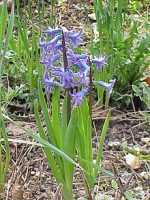 Native to rocky regions of southwestern Asia, including parts of Turkey, northwestern Syria, Lebanon and northern Israel, the common hyacinth become known as the Dutch hyacinth when it was introduced to Europe in the 16th century. It is a bulbous perennial and a member of the asparagus family, Asparagaceae, that also includes lily of the valley, yucca, and hosta. Plants grow 6-12″ tall and have 3-4 basal whorl of narrowly strap-shaped leaves . In mid spring a single stiff leafless flowering stem appears bearing 2-50 heavily scented tubular flowers with 6 reflexed petals. The species has purple petals but many varieties and cultivars have been produced so that white, pink, peach, and red. In addition, some varieties multiple flowering stems and flowers with a double row of petals. The popularity of the common hyacinth has varied over the years and at their peak of popularity a single bulb sold for $300. The plants are especially attractive when planted in groups in borders, beds, and rock gardens. They are good for containers and can be forced for Christmas bloom. Although perennial, plants tend to decline in a few years and have to be replanted. All parts of the plant are moderately poisonous if ingested and can irritate the skin of sensitive individuals. The genus name, Hyacinthus, honors a ancient god associated with the rebirth of vegetation. In ancient Greek mythology the beautiful youth Hyakinthos was accidently killed by Apollo and from his blood sprang the plants named in his memory, although modern scholars believe Gladiolus italicus was intended. The specific epithet, orientalis, indicates the eastern origin of the plant.
Native to rocky regions of southwestern Asia, including parts of Turkey, northwestern Syria, Lebanon and northern Israel, the common hyacinth become known as the Dutch hyacinth when it was introduced to Europe in the 16th century. It is a bulbous perennial and a member of the asparagus family, Asparagaceae, that also includes lily of the valley, yucca, and hosta. Plants grow 6-12″ tall and have 3-4 basal whorl of narrowly strap-shaped leaves . In mid spring a single stiff leafless flowering stem appears bearing 2-50 heavily scented tubular flowers with 6 reflexed petals. The species has purple petals but many varieties and cultivars have been produced so that white, pink, peach, and red. In addition, some varieties multiple flowering stems and flowers with a double row of petals. The popularity of the common hyacinth has varied over the years and at their peak of popularity a single bulb sold for $300. The plants are especially attractive when planted in groups in borders, beds, and rock gardens. They are good for containers and can be forced for Christmas bloom. Although perennial, plants tend to decline in a few years and have to be replanted. All parts of the plant are moderately poisonous if ingested and can irritate the skin of sensitive individuals. The genus name, Hyacinthus, honors a ancient god associated with the rebirth of vegetation. In ancient Greek mythology the beautiful youth Hyakinthos was accidently killed by Apollo and from his blood sprang the plants named in his memory, although modern scholars believe Gladiolus italicus was intended. The specific epithet, orientalis, indicates the eastern origin of the plant.
Type: Herbaceous, perennial spring flowering bulb
Bloom: Scape of 2-50 blue tubular very fragrant flowers with 6 reflexed petals, in mid spring
Size: 6-12″ H x 4-6″ W
Light: Full sun to part shade
Soil: Fertile, medium moist, well-drained; somewhat drought tolerant.
Hardiness: Zones 4-8; grows best in cool climates and must have a dormancy period.
Care: Replace frequently as bulbs decline and do not return reliably.
Pests and Diseases: None of significance but will rot in poorly drained soil
Propagation: Division of offsets, seed
Companion Plants: Bleeding heart, grape hyacinth, tulip
Outstanding Selections: Over 2,000 cultivars are avaialbe that vary in flower color, petal number, and number of flowering scapes.
Photo Credit:Wikipedia